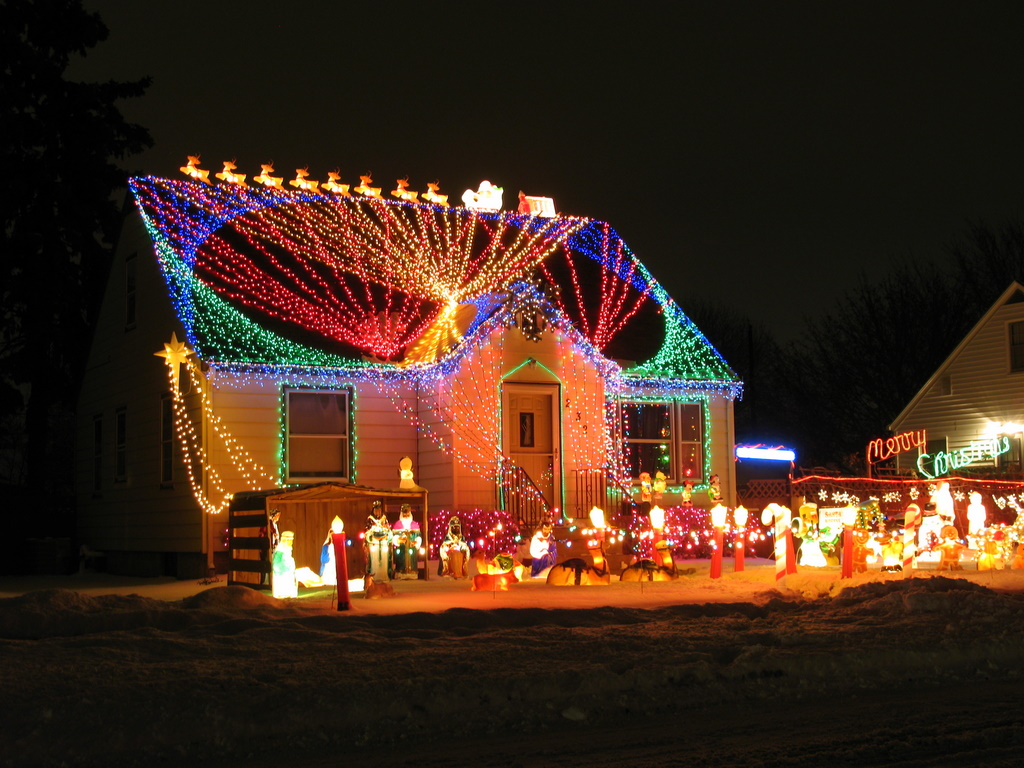
We stayed home and did stuff around the homestead. I was thinking about Christmas and looked up on the Internet Wikipedia site and found these great tid-bits of information on Christmas Lights and some pix to go with.
Christmas lights are lights used for decoration around Christmas. The custom harks back to the use of candles to decorate the Christmas tree in upper-class homes in 18th century Germany where it was occasionally decorated with candles, which at the time was comparatively expensive light source. Candles for the tree were glued with melted wax to a tree branch or attached by pins. Around 1890 candle holders were first used for Christmas candles. Between 1902 and 1914, small lanterns and glass balls to hold the candles started to be used. Early electric Christmas lights were introduced with electrification, beginning in the 1880's. Christmas trees displayed publicly and illuminated with electric lights became popular in the early 20th century. By the mid-20th century, it became customary to display strings of electric lights as Christmas decoration detached from the Christmas tree itself, along streets and buildings. In the United States, it became popular to outline private homes with such Christmas lights in tract-housing beginning in the 1960s. By the late 20th century, the custom had also been adopted in non-western countries, notably in Japan.
The first known electrically illuminated Christmas tree was the creation of Edward H. Johnson, an associate of inventor Thomas Edison. While he was vice president of the Edison Electric Light Company, he had Christmas tree light bulbs especially made for him. He proudly displayed his Christmas tree, which was hand-wired with 80 red, white and blue electric incandescent light bulbs the size of walnuts, on December 22, 1882 ( Happy Birthday Christmas lights) at his home on 5th Avenue in New York City. Local newspapers ignored the story, seeing it as a publicity stunt. However, it was published by a Detroit newspaper reporter, and Johnson has become widely regarded as the Father of Electric Christmas Tree Lights. By 1900, businesses started stringing up Christmas lights behind their windows. Christmas lights were too expensive for the average person; as such, electric Christmas lights did not become the majority replacement for candles until 1930.
Over a period of time, strings of Christmas lights found their way into use in places other than Christmas trees. Soon, strings of lights adorned mantles and doorways inside homes, and ran along the rafters, roof lines, and porch railings of homes and businesses. In recent times, many city skyscrapers are decorated with long mostly-vertical strings of a common theme, and are activated simultaneously in Grand Illumination ceremonies.
The technology used in Christmas lighting displays is highly diverse, ranging from simple light strands, Christmas lights (aka Fairy lights in the UK), through to full blown animated tableaux, involving complex illuminated animatronics and statues.
Christmas lights (also called twinkle lights, holiday lights, and mini lights in the US and fairy lights in the UK), that are strands of electric lights used to decorate homes, public/commercial buildings and Christmas trees during the Christmas season are amongst the most recognized form of Christmas lighting. Christmas lights come in a dazzling array of configurations and colors. The small "midget" bulbs commonly known as fairy lights are also called Italian lights in some parts of the U.S., such as Chicago.
The types of lamps used in Christmas lighting also vary considerably, reflecting the diversity of modern lighting technology in general. Common lamp types are incandescent light bulbs and now light-emitting diodes (LEDs), which are being increasingly encouraged as being more energy efficient. Less common are neon lamp sets.
Now for the Green Part
Environment and recycling
Every year, 20+ million pounds of discarded holiday lights make their way to China, the world capital for recycling Christmas lights. The region began importing discarded lights around 1990 in part because of its cheap labor and low environmental standards. As late as 2009, many factories would simply burn the lights to melt the plastic and retrieve the copper wire, releasing toxic fumes into the local environment. A safer technique was then developed that involved chopping the lights into a fine sand-like consistency, mixing it with water and vibrating the slurry on a table causing the different elements to separate out, similar to the process of panning for gold. Everything is recycled: copper, brass, plastic and glass.

Main article: Christmas lighting technology

No comments:
Post a Comment